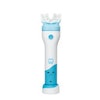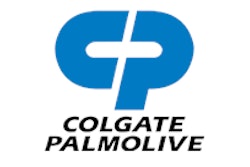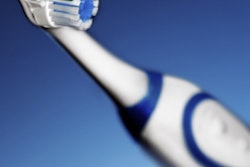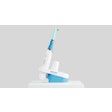
Gingival bleeding and plaque levels were reduced in outpatient stroke rehabilitation patients who were enrolled in oral hygiene instruction programs in a new study. This could reduce the risk of oral opportunistic pathogens and pneumonia, according to the study authors.
Since controlling plaque and gingival bleeding is important to the oral and overall health of stroke survivors, researchers sought to compare the effectiveness of two oral hygiene care programs in stroke patients who were undergoing outpatient rehabilitation. Both programs appeared effective at improving the participants' oral health, although one that incorporated a powered toothbrush and chlorhexidine mouthwash produced more pronounced results, the researchers reported in their study published in the Journal of Dentistry (April 6, 2017).
"This highlights the value of oral hygiene programs within stroke rehabilitation and provides evidence to advocate for the inclusion of oral hygiene care programs within stroke rehabilitation," the study authors wrote.
The authors, led by Ruoxi Dai, PhD, were from the University of Hong Kong Faculty of Dentistry and the rehabilitation medicine department at Tung Wah Hospital in Hong Kong.
Combating plaque
The number of stroke survivors has markedly increased in recent decades. Motor, sensory, perceptual, and cognitive poststroke deficits can affect daily functioning in these patients, including oral self-care, the authors noted.
Stroke patients can experience orofacial functional impairments that include decreased salivary flow, lip force, and chewing efficiency that can impair the ability to clear food from the mouth, they explained. These factors can increase plaque levels, which can lead to plaque-induced oral diseases. These plaque levels, in turn, can make these patients more vulnerable to oral opportunistic pathogens associated with pneumonia, increasing the risk of death, according to previous research. Gingival bleeding also caused by poor oral hygiene can lead to bacteremia, which can have life-threatening consequences.
For these reasons, interest has been growing in including oral hygiene programs in outpatient stroke rehabilitation. However, only limited information is available about the effectiveness of such programs. Self-care is preferable to assisted care, the authors noted, since outpatient stroke rehab patients have regained some of their functional abilities, and assisted care of community-dwelling individuals could burden family caregivers.
The researchers conducted the current study to compare the effectiveness of an "advanced" oral hygiene care program to a "conventional" hygiene care program at controlling plaque levels and reducing gingival bleeding in outpatient stroke rehab patients with normal cognitive abilities.
Stroke patients who had been admitted to one outpatient rehabilitation facility in Hong Kong within the previous six months were eligible for the study if they met the following criteria:
- Had moderate to severe functional disability
- Were not edentulous
- Had no more than mild cognitive impairment (score higher than 18 on the Mini-Mental State Examination [MMSE])
- Could follow a one-step command
- Did not have an indwelling nasogastric feeding tube
The study included 94 individuals (57 men) with a mean age of 66.6. Of the total group, 74 patients (78.7%) were assessed at the end of the clinical trial at three months, and 57 (60.6%) three months later.
After being randomly assigned to one of the two groups, the participants underwent a 30-minute one-on-one hygiene training session with a dental surgery assistant. The patients were provided with a standardized oral hygiene pamphlet and a demonstration of proper oral hygiene on tooth block models. They were then asked to demonstrate how they brush their teeth.
Participants in both programs were provided with standardized toothpaste (Colgate Maximum Cavity Protection, Colgate-Palmolive). Members of the conventional group also received a manual toothbrush (Oral-B Pro-Health All-In-One, Procter & Gamble), while the advanced group received a powered toothbrush (Oral-B AdvancePower 400 series, Procter & Gamble), the manufacturer's instructions for the toothbrush, and a three-month supply of 0.2% chlorhexidine gluconate mouthwash (Corsodyl, GlaxoSmithKline). They were told to rinse twice daily with 10 mL of the mouthwash for at least 30 minutes after brushing.
Before experiencing a stroke, 76.9% of the patients were not regularly alcohol users, and 67% did not smoke. Ischemic stroke was experienced by 70.2% of the participants, and hemorrhagic stroke in 29.8%. Their average grip strength of their dominant hand was 21.4 kg, with 43.2% having their dominant side impaired by stroke.
Only 5% of the patients reported a dental visit within the previous year, with almost 75% saying they did not brush their teeth daily. At baseline, they had a mean number of decayed, missing, and filled teeth (DMFT) of 14.7. Periodontal pockets 4 mm or larger were found in 76 (80.9%), and 69 (73.4%) had attachment loss of 4 mm or more. Almost 95% of the patients did not have any oral mucosal lesions. About 20% wore a denture.
At baseline, the median percentage of sites with moderate to abundant plaque in both groups was about 95%. After three months, the median percentage of sites with moderate to abundant plaque significantly reduced to 83.3% in the conventional group and to 51.5% in the advanced group. Meanwhile, the percentage of sites with gingival bleeding dropped significantly from about 49% in both groups to 40% in the conventional group and 33.3% in the advanced group.
“The advanced oral hygiene care program was relatively simple and should be advocated for use in stroke outpatient rehabilitation programs locally and internationally.”
At six months, the advanced care group still had a significantly smaller percentage of sites with moderate to abundant plaque compared with the conventional care group and a significantly smaller percentage of sites with gingival bleeding.
Individuals who reported an irregular brushing habit at baseline were significantly more likely to have a greater percentage of moderate to abundant plaque sites at three months than those who reported brushing regularly, as were they more likely to have a greater percentage of sites with gingival bleeding.
Staining levels on anterior teeth and calculus levels on lower anterior teeth were similar between the groups at all times. However, the change in staining levels and change in calculus levels were significantly greater in the advanced care group.
"Oral hygiene would appear to remain neglected following hospital discharge and thus there is a need to consider oral hygiene care programs not just in the hospital setting but also in outpatient rehabilitation," the authors wrote of their results. "Significant improvements in oral hygiene and reduction in gingival bleeding were identified at the end of the clinical trial among all participants. This provides evidence of the effectiveness of both oral hygiene programs within rehabilitation."
Advocacy urged for oral care programs
The study authors noted some drawbacks to their results. Participation in the advanced care group was associated with extrinsic teeth staining and increased calculus levels, which was likely due to the use of chlorhexidine, they explained.
Additionally, lower cognitive ability measured at baseline was associated with greater levels of plaque and gingival bleeding at the end of the study, suggesting that such patients may need additional support and assistance with dental hygiene.
Despite these limitations, the authors noted that the advanced hygiene care program should be used in outpatient stroke rehabilitation programs. Due to the reduction in plaque, it could be effective in reducing oral diseases and aspiration pneumonia.
"The advanced oral hygiene care program was relatively simple and should be advocated for use in stroke outpatient rehabilitation programs locally and internationally," they concluded.



















